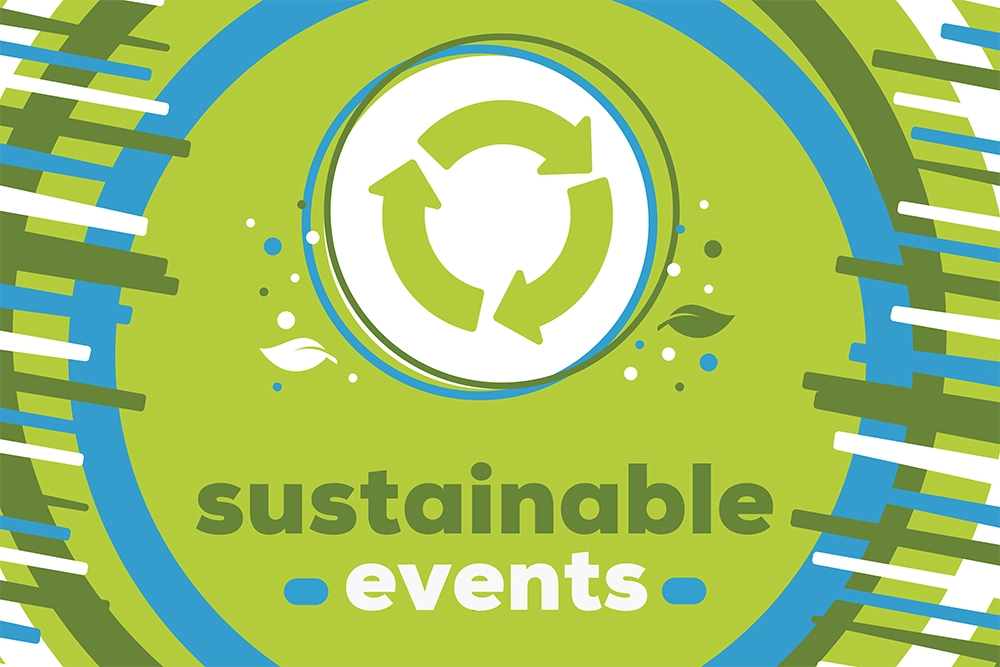People are looking for events that align with their personal values and ideals. According to Skift Meetings, “social consciousness matters to a large proportion of your current or potential attendees.”[1] Not only that, but we also all know that planning events takes a lot of resources, both in terms of staff time and materials. By incorporating sustainable practices into your events, you may attract more participants, or they may be more likely to return to future events. We can save time, resources, and money – and as an added plus, we can help the environment!
A few ideas for your next event:
1. Ask the venue about their sustainability practices. Look for properties that have recycling programs not just for attendee disposables (cups, soda cans, bottles, paper, etc.).Also ask what the property does for cardboard, refillable products in guest rooms, etc. At Boomerang Events, we include this as a standard question in our RFP’s and selection criteria.
2. Donate extra food and beverages. Admittedly, this one is a hurdle with many properties and their legal team. It also takes a little creative thinking and coordination. Many events will have extra food especially boxed lunches which sadly is disposed of. Work with properties to have any remaining food and beverages donated to local shelters. Always be upfront about this in your RFP and incorporate language into the contract.
You’ll likely get push back immediately that this isn’t possible due to liability issues. While we do understand the liability with food temperatures and the lack of control once the food leaves the premises, it is possible. One way overcome the venue declining to donate food is to coordinate it yourselves. Identify a local shelter ahead of time to coordinate the acceptance/pickup. In this scenario, the venue boxes up the food and the planner/client are the one making the donation.
3. Find a new purpose for extra Bags/swag. With minimums and price breaks you will likely have extra bags from your event. Instead of taking them back to the office storage, donate them to a local organization. One idea is to fill the bags with hand sanitizer, Kleenex packs, hygiene products and give to a local shelter. This can be done at the conference site (arrange for a drop-off, courier or staff member from the organization) or once you get back to the office. You can also donate them as is since many individuals need an empty bag to help them carry or store their things: think kids in the foster system and other vulnerable populations.
4. Use event apps and reusable signage. Event apps are a great option to reduce or eliminate the amount of paper waste at your next conference. Printed programs, exhibitor maps, slides/handouts, are at your fingertips in the app. Concerned about attendees that resist using apps? Print a condensed version of the schedule and map for those that askand have a table at your event for help with and troubleshooting for the app. You can also add messaging to your registration confirmations and “Know Before You Go” emails about your commitment to reducing waste.
Signage is another way to reduce waste by reusing as much as you can for repeat events. This is easier for some events than others from a branding standpoint and location, but it can be done. A few ideas:
- Directional signage that does not include a date/year – these can then be reused year after year if stored properly. Additionally, instead of using foam mounted boards for these purposes, consider a different substrate.
- Use registration banners or signs that can be reused for future events.
- Take advantage of venue’s digital boards for branding, session information, etc.
5. Find creative ways to coordinate transportation. Many event apps now have features to arrange ride-shares. We typically include this as a suggestion when sending out emails to attendees with app login. Does your conference have groups or multiple staff members from one organization attending? If so, encourage them to carpool to save on carbon footprint and parking fees.
There are many more ideas to blend sustainability into your next conference. You don’t have to do everything at once. Making sustainability part of your planning is good for everyone. What ideas do you have or ways you’ve done this at past events?
[1] https://meetings.skift.com/sustainable-event-management/

